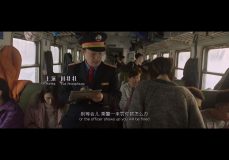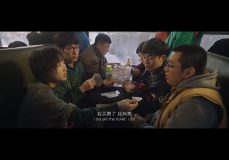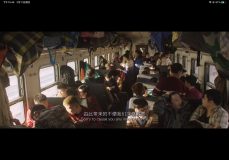US AND THEM; Rene Liu(刘若英), 2018
Train carriage, Dalian
Us and Them tells a love story of regret. A young man and woman met on a train on their way home for the New Year. They fell in love and split up and met again ten years later. The camera moves along the aisle and film the back of the girl.
The camera moves along the aisle and film the back of the girl.
The girl turns around, and the sun shines on her face.
The open and narrow space in the carriage allows the conversation between the girl and the ticket inspector to be overheard by the boy. The space inside the train is characterized by a narrow aisle for passengers to move with the flow of people. To create a sense of immersion for the audience, the camera slowly moves in one direction. Although the camera keeps filming the heroine’s back, it does not move to the front to capture her face. As the boy speaks, the girl turns around. Thecamera’s direction changes for the first time, facing the boy, which reminds the audience that the story between them has officially begun.
 the camera shoots the boy and the girl from the side, creating a crowded effect.
the camera shoots the boy and the girl from the side, creating a crowded effect.
After that, the camera shoots the boy and the girl from the side. The characters in front partly block the characters behind, overlapping to create a crowded effect. This shot lasts for half minute, giving the impression that the boy and girl are very close to each other. It gives a hint that their relationship is rapidly drawing closer from the viewpoint of space and physical distance.

The camera shoots them from the outside.
When the broadcast informs that the front is impassable due to heavy snow, the camera shoots the window from the outside and there are no other passengers in the picture but only the two main characters, as if they are the only ones in this space. They look out the window and see deer in the snow, and plan to get off the train and walk home together. At this point their space is no longer confined within the carriage but extends to the outside of the train.
The camera is shooting the passengers in the train from above.
In the film, the abundance of greens and the sunshine through the windows create a feeling of calm and warmth. But in reality, the unpleasant smell, small space and noisy environment of trains of a decade ago would make people feel uncomfortable. Besides, when the boy and the girl sitting side by side the camera angle produces a sense of crowdedness, but when people actually sitting on the train, the seat space is more spacious. The camera just deliberately makes the space look small to create a sense of intimacy between the protagonists. Moreover, people cannot see so many different perspectives when sitting on the train, such as looking down on the passengers from above and looking at the people in the windows from outside the train, while the transition of the film’s scenes allows the audience to experience many perspectives that are unlikely to be realized in the real life.
Space is narrative as it contributes to the development of the storyline. The space and shots in the film depict the beauty of the boy and girl’s first encounter. It is an encounter full of coincidences. In such a crowded and noisy space, but it happens that the boy picks up the girl’s ticket. All the spatial clues indicate that their relationship gradually becomes intimate and the relationship will continue outside the train, foreshadowing that more stories will happen after their beautiful first encounter.
Zhou Yingqi, 3035919793
You described how the train space was portrayed from various angles and with various visual techniques. You also made meaningful connections between these descriptions to the film’s plot and the emotions evoked. While you did draw some comparisons to the actual space of a train, they are rather general. It is unclear if you had carried out a virtual field trip. For example, is it possible to identify the exact train route being depicted in the film, and collect more information about the train (e.g. its model) and the surroundings in which it passes through? Lastly, you are reminded to cite any references used.